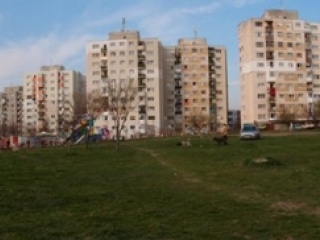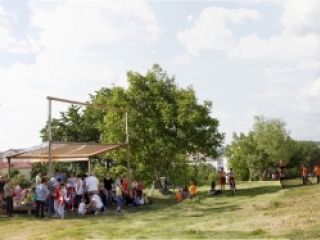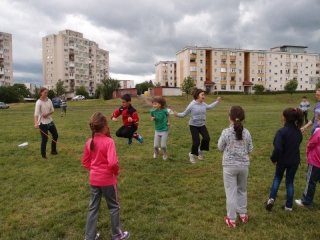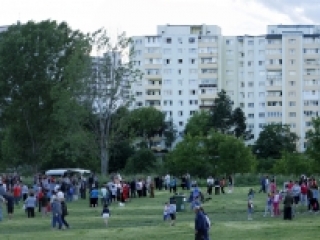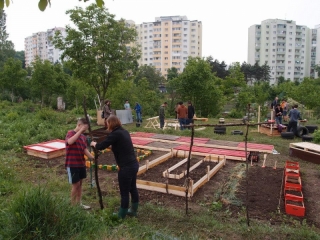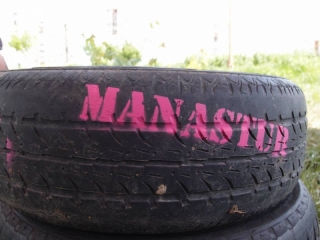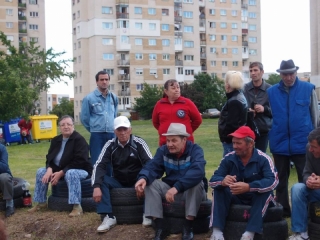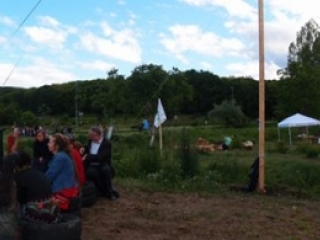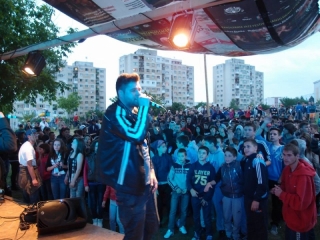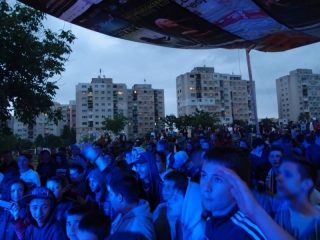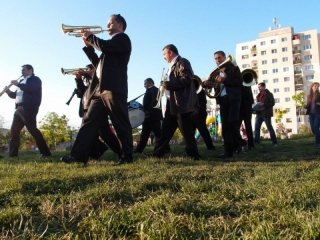- INTRODUCTION
- LECTURES
- Miles Glendinning / The Hundred Years War: a ‘Long Century’ of Mass-Housing Campaigns Across the World
- Auguste Van Oppen and Marc Van Asseldonk / Open-Source Urbanism
- Tim Rienets / Less Is More? Urban Design and the Challenge of Shrinking Cities
- Adam Bobbette and Etienne Turpin / Aberrant Architecture: Typologies of Practice
- Matthias Rick / Fleeting Architecture ‒ Raumlabor’s Instant Urbanism
- ESSAYS
- Nerijus Milerius / Breaking Point: from Soviet to Post-Soviet City
- Benjamin Cope / A Reflection on Breaking Points in the Case of The Praga District of Warsaw
- Miodrag Kuč / Berlin. Becoming Normal?
- Mindaugas Pakalnis / Vilnius. The Challenge of Disintegration
- Siarhei Liubimau / Popular Urbanism and the Issue of Egalitarianism
- INTERVIEWS
- No Trust – No City / Matthias Rick Interviewed by Ona Lozuraitytė and Aistė Galaunytė
- The Man, Who Turned the Barbeque into the Center of the World / Benjamin Foerster-Baldenius
- Radicalising the Local / Jeanne Van Heeswijk Interviewed by Kotryna Valiukevičiūtė
- Learning-By-Doing / Laura Panait Interviewed by Arnoldas Stramskas
- Preserving the Generic / Kuba Snopek interviewed by Marija Drėmaitė
- A Permanent Anticipation of Uncertainty / Adam Bobbette interviewed by Arnoldas Stramskas
Laura Panait is a member of Colectiv A in city of Cluj, Romania. She did her PhD in urban anthropology which centered on art and public space in post-1989 Romania. She has been engaged in variety of urban and artistic projects, including Romanian pavilion at the Venice Architectural Biennale in 2010 called Superbia.
As a way of introduction, it would be useful to get a bit broader context in which you are working. How the urban environment has been changing and affected by economic and political restructuring in the 1980s and 1990s?
We work in a complex and a so-called ‘transitional’ (one may ask transitional to what?) society, Romanian society. The rapid changes make this context quite hybrid and always adapting to new issues imposed by politics. The urban environment is still dealing with the communist heritage when speaking about neighbourhoods. The urbanism created in the 70-80s is still surviving but also, due to more individualistic usage, is under constant change. In this story, the public space is mostly affected and becoming less public and more and more affected by the rush of the capitalist developments. In our case, Manastur Neighbourhood is the biggest and the greatest example in Cluj when dealing with social housing in blocks of flats, the suffocated public space and the lack of green areas. The main pressing issues for this area but related to other issues as well is the lack of green public spaces as spaces of agoras. In parallel with this, the real estate developing pressure was frozen for a while, due to the crisis, but now recovering and starting to put more price on private land, no matter what the consequences on the common and public spaces in the city that may have.
What makes Manastur Neighborhood worthwhile of engagement? What is its specificity?
Manastur is the biggest communist neighborhood of the city, inhabited by more than 100 000 people. It used to have a strong workers component but now it is changing, a lot of young people moving in. There is only one big green area in the district. There were some moments (I know two) in the post-communist history of the district in which people mobilized against a parking building and against the building of a 25 stories block. But it seems it wasn’t enough, because in the both cases they lost, the buildings being built. So there are germs of reaction but we work together in developing and moving forward.
The main issue we approached is the fact that our site, La Terenuri/At the Playgrounds Manastur we have chosen is a legislative puzzle and is in danger of private interest even if in the actual master plan is a green area. The complex relationships between pre-communist rural property, communist understanding of common space (public space) and post-communist claiming of property make uncertain the only green area in the biggest neighborhood in Cluj. The materialization of this relations gave birth to one of the most interesting urban phenomena in Cluj: urban gardening starting from late 1970s. People brought here to live and work in the socialist city came from the rural areas. So they started to “occupy” the abandoned land in front of their block of flats even if the land wasn’t their property. The communist regime tolerated this way of spending free time, and they survived after 1989 too. Even the real estate boom of late 2000 didn’t affect them completely (some were demolished in 2010). The Crisis reduced the pressure but still there are a lot of property claims unsolved and the only thing that keeps away the pecuniary investments is the bureaucracy between private-state-public interests. Meanwhile, the local people are using this place totally informally. This is the complex context in which we intervene trying to reinforce the community.
Who are you working with? What kind of community constitutes this area?
Our community is a complex story formed by old gardeners, former factory workers, but also the younger generation divided by working migration, unemployment and also younger children not knowing which direction to take anymore in this complicated Romanian transitional context. In total, more than 5000 people use the green area we are dealing with, but they are divided in many groups of interest, age, gender, etc. As key actors, we mainly work with the groups of children, teenagers but also with the gardeners with their skills and experiences from the past. Also urbanists, arhictects, landscape architects and artists are part of our initiative. Moreover, the Town Hall of Cluj is an actor we are negotiating constantly with, as a partner.
What is your initiative or intervention?
Our community project is taking place on an empty vast green space between the blocks, surrounded by dozens of 30 years old gardens of the old workers and also by a forest. Manastur neighbourhood is the densest and largest one in the city, a workers place with blocks, having a lack of public space, due to the developments after the 1990. It’s the only green big space of Manastur, once planned in the 1980s as a park, but then the idea being abandoned. Everybody uses now this space freely (walking the dogs, gardening, playing sport, walking in the forest, sun bathing, etc.) but quite individualistic. So we first created a Common Space for the Community to meet, exchange memories and thoughts about the place and also talking about the future they want for this space and how we can stand together for a shared space, to make an informal network between different and diverse categories of local people (depending on interests, age etc).
Tell me about how you got yourself involved in Colectiv A? How it is organized? Who is involved? Is it through Collectiv A that you are organizing or is it one actor amongst others?
I am part of Colectiv A since its establishment in 2009. I am an urban anthropologist looking for more practical means of approaching the issues of urban communities. We started as a performative association, coordinating Temps d’Images Festival. Then from 2012, a new direction was born: cultural interventions within the public space of the Manastur Neighborhood and particularly in ‘At the Playgrounds’ Area (‘La Terenuri’ in Romanian). We started with an EU funded project ‘Landscape Choreography’ (also happening in 2 other countries: Italy and Germany). Meanwhile more people got involved (from architects, landscape architects, activists, artists, psychologists, inhabitants) and now we are called ‘At the Playgrounds Initiative’ coordinated by Colectiv A.
You mentioned that there are these different people with various backgrounds. But how does it work? What kind of structure you have? What kind of methods of working together you test? Do you do long term planning or do it more spontaneously according to situation present? And is there a relation, in your opinion, in terms of this collective and the residents that you engage with? In other words, is your organizational model or its flexibility bring different outcomes in the work you do?
We have a horizontal team composed of interdisciplinary backgrounds. Still there is need for coordination and reminders and I am doing this. We work on short and medium term planning. We have projects for the present year and we work on planning and implementing them together inside the team but also with the groups involved from the community. But of course we learn by doing it, still. We constantly adapt our activities to the daily context of the area. Lately, we decided to work with children and teenagers and they are the most active and engaged in what we do. They take it as a play but we make them realize all the work we do there is for the common benefit of the others. Of course, we also engage older people when it is about skills, knowledge of the area and responsibility of the common future we dream of. We are different people with different background but still being very motivated to continue together due to this necessity of activating this space and also from the risk of loosing. The emotional involvement is a lot giving by the interaction with the members of the community, especially with the children. But in general, our collective is quite well balanced.
I would like to hear about these different scales you operate. There are municipal politics, district’s residents, people like you who come with some notion of community self-organization. How does it work in this particular context? How do you approach these different actors? What are the challenges?
We have more levels of working: from negotiating with the municipality, to raising awareness in the neighborhood about the potential of this big green area ‘At the Playgrounds’. We organize events for the community of users using this space, ranging from workshops, building from recycle materials, debates, concerts and others. We have some moments when the Municipality is involved also supporting some community events, even if this space is still under a juridical cloud and uncertainty. We work also with urbanists from Cluj, animal activists, environment actors, public space theoreticians (sociologists, architects, etc.) in trying to find common grounds for action within this area.
For me one of the most pressing and challenging issues, is how do you move or expand from cultural or more social engagement to something that could be called political? Have you figured that out? How do you build trust, establish relationships and expand the field of those relationships to include other spheres?
Yes, for us it was a challenge moving from cultural to a more social approach and engagement. It has to be like that for us, if we really consider the daily needs of people for this area: a place for leisure, enjoying the green space and the forest, a free time but a neglected area. We started to build trust by doing things (learning by doing them) and by keeping contact with all the actors involved. Many people didn’t expect from us to be so engaged on long term here and we show that a simple intervention in the space in fact is developing into a more deep understanding of how we all can reshape our future public spaces.
Do urban studies have been/are useful at all in doing these kinds of interventions concretely and locally? Is there some kind of intellectual or theoretical tradition which you utilize in this day to day work with community and local politics?
Urban studies gave us models of other successful stories but didn’t teach us how to do it. Our initiative is learning-by-doing it, or learning it through action. All the years I have spent in theory demonstrated me that without practice nothing is possible and this was missing from our context: more action in the public space. So even if we still learn from the community and from how each of us is using a space, we think all of our efforts more as a process than a project, with success but also small failures.
There is this critique of the groups, initiatives, NGO’s etc in Central and Eastern Europe that most frequently they have western orientation, but do not do enough locally, or not generate knowledge locally, but basically try to implement practices that are not at all or only partially applicable in this regional context. As well, I guess, the lack of sharing practices and critical insights within the region. What is your take on it?
Yes, indeed, we lack critique in the East and we start often from the Westerns ones. In the end we produce a blend of Western theory with Eastern perspectives/applications, but its not about importing West in East but more understand East through West (also vice versa), resulting in a new context to deal with, in practice.
Do you see your initiative as local or is it connected to similar initiatives in Romania or other places? What is your take on this proliferation of urban art, community, participation encouragement models? How do you see you initiative in this broader context?
We are connected to few initiatives like ours but more concerning urban gardening and urban interventions (example: Studio Basar Bucharest). We are still lacking this kind of initiatives here in Romania. A lot of studies are being made on us but on the other side we don’t see yet other initiatives like this growing locally or nationally. So maybe come back with this question in a few years, we are still not ready to answer to this completely…
Tell me about some of the daily encounters, events, problems? I was very curious to hear about the local gang you work with and go mushroom picking with them for example. Or another area of work is dealing with the tensions of residents with local Roma population. What is your approach?
Every day can be different At the Playgrounds, but in the same time being a normal rhythm of the area: people walking dogs, Roma people coming down from the forest to look for some food or materials to recycle, women doing sunbathing and other practices. But all of these groups doing certain activities share this space individually, not in common. This we need to reinforce more here in order for the citizens to reclaim their right to have this green area public. We are facilitators between Roma and the majority, between the dog owners and the others, trying to find with them solutions to share this space more peacefully and constructing some commonality of this shared space and then more consolidated voices for ethical rights of everybody upon this space. A lot of people using this space live next to it but also another part of the users are from other neighborhoods. The common thing which brings them together now is the green area but also the forest next to it, so being an oasis in the middle of the neighborhood.
What is the role of art in these practices? What art does that other approaches, practices don’t? And how it helps or maybe inhibits what are you trying to achieve?
Art brings people together showing them ways of interactions and methods that they don’t use daily in this space. Opening this space to a new creative approach makes the social part of the process easier and more joyful. Especially the children and teenagers desire more artistic input there, seeing in us a completely new gate to innovate in this space but also in their lives. Art also tries to re-create a civic voice in the area and for the neighborhood. Having this aim of togetherness follows a new level, of doing things together, seeing more potential in this space, new ways of exploration but also of usage of a green area. In the end, artistic practices try to soften tensioned relationships and introduce new temporary solutions for the space, being more playful with the urban context. So playing more soft in a hard environment can be a chance of seeing solutions in a more flexible way.
How do you think – or act – in terms of sustainability of your project/work. What do you think sustainable means would be to maintain this initiative? What are the pros and cons of EU or other project finances? There is a lot of effort from somewhat exterior actors, such as your collective, but how do you imagine the district residents could organize themselves and with what means without this extra-support?
This is a hard question: our projects here are sub-financed. We have some finances from the Town Hall and others from the Community Foundation from Cluj (crowdfunding). But in some activities we ask people to contribute with tools and skills. The residents are still far from organize themselves and we are still in the level in which we bring them together and working for this green area and for it future. Again, it’s a question we should answer in a few years, because now we feel like it is too early. Of course, ideally speaking, for us the main goal is to let the inhabitants from the area organize their own space and reclaim it as an official park.
What are the plans for the near future? What is the big goal (if you pose one)?
Our goal had many layers since the beginning. We started as an artistic initiative to reclaim public space. Now we also focus more on the social aspect of living in the city. It is like a Pandora box of many problems. First, we were overwhelmed, but then we tried to gather other NGOs and initiatives to help us tackle these problems. The overall goal is to help people become more active through whichever vehicle – public space, urban gardens, and environment. The big goal is gaining this space as a public green space of the city, in showing to the authorities and to the city of Cluj that a green space is a something to value more in the future.





